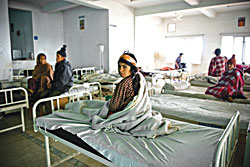 SAM KANG LI |
Nepal is trying to do just that by introducing policies to make access to essential health care services more equitable. The goal is for essential services to be as available to the poor and marginalised as services are to advantaged castes and ethnic groups. At present, free health care is targeted to the poor and other disadvantaged groups at district hospitals and primary health care centres.
Treatment is free at health and sub-health posts, and the government will introduce free maternal care at all health institutions and expand universal free care to all district facilities in the near future.
The number of clients using government health facilities has increased since fees for services were abolished, especially in the Tarai. But Nepal faces challenges to ensure equitable access to essential health care services for all citizens.
Inequalities between castes and ethnic groups persist in the use of government health services and in the health of Nepal's people, just as inequities linger between the poor and those who are better off. But the results of surveys conducted in 1996, 2001, and 2006 show that significant progress has been made in reducing these differences.
Over the 10-year period, more poor families and people from marginalised castes or ethnic groups have benefited from family planning services, diarrhoeal disease control, treatment for acute respiratory infection, and childhood immunizations. At the same time, differences in the size of babies at birth, and infant and under-five mortality have decreased markedly. The equity gap has narrowed.
Use of modern contraception is much more evenly distributed now among castes and ethnic groups. The incidence of diarrhoea has decreased sharply among Dalits, from 30 per cent in 1996 to only 9 per cent in 2006. In 1996 'high caste' children were more likely to benefit from treatment of acute respiratory infection than Dalits. Ten years later, more Dalits than the 'high castes' were benefiting from the treatment. Treatment of acute respiratory infection among Muslims has also risen.
Inequalities in rates of childhood immunisations have decreased between castes and ethnic groups over the last decade, as they have between the richest and the poorest, but children from wealthier families are still more likely to benefit from immunisations.
Regrettably, disparities in antenatal care between castes and ethnicities have increased. Antenatal visits by the wealthiest women from more advantaged castes or ethnic groups have increased much more rapidly than visits by the poorest. We need to close this gap to help ensure safe pregnancies and healthy newborns.
The number of babies born smaller than average is decreasing faster among the poorest than the richest, and the new policy of free delivery care at government health care institutions aims to reduce maternal and neonatal mortality, especially among the poor and women and children of marginalised castes and ethnic groups. Disparities in rates of neonatal mortality, however, have increased slightly over the decade.
Under-five and infant mortality rates are still higher than the national average among marginalised castes and ethnic groups, but they have declined sharply since 1996. The gap in child survival is closing.
Remarkable gains have been made in reducing inequalities in access to and differences in utilisation of health care services between castes and ethnic groups, as well as between poor and wealthier citizens in Nepal since 1996. Health outcomes have also improved for the poor and marginalised.
However, inequalities in access and use persist and are increasing for some services. The government is addressing these inequalities in the delivery of health care and actively working to lower the number of deaths of the newborns, infants, and young children of poor and marginalised families.
Robert Timmons is team leader of the Health Sector Reform Support Program, Ministry of Health and Population



